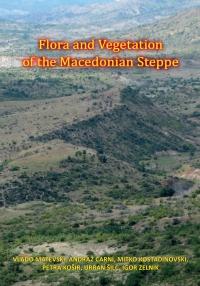Flora in vegetacija makedonske stepe / Flora and Vegetation of the Macedonian Steppe / Flora i vegetacija na makedonskata stepa
In the central part of Macedonia, in the triangle between Veles, Štip and Negotino, there is a vast area that is different from the rest of the country. The entire area slightly resembles an undulating sea, as its surface is interrupted by numerous ditches, which makes the region almost impassable.
Bedrock is composed of Paleogenic, and more rarely Neogenic sediments, among them there are sandstones, marl sandstones, clays, sandy clays, carbonates, marls and others. All Paleogenic sediments are of marine origin and therefore extremely salt-rich. In the region the erosion is extremely severe; water and frost cause sediment layers to decay into small particles, which are later carried away by water.
The work deals with a survey of flora and vegetation. After the analysis the most important species and vegetation types/habitats have been established. According to this the most important localities have been defined.
The floristic investigations deal with endemic, halophytic, steppe and other rare plant species. There are eight endemic plant species: Hedysarum macedonicum, Astragalus cernjavskii, Tulipa mariannae, Onobrychis megalophylla, Ferulago macedonica, Heptaptera macedonica, Salvia jurisicii and Potentilla tridentula. There appear also some significant steppe (Astragalus parnassi, Morina persica and Convolvulus holosericeus) and halophytic (Artemisia maritima, Artemisia annua, Krascheninnikovia ceratoides and Camphorosma monspeliaca) species, as well as numerous other, rare plant species.
The study of vegetation results in a systematic overlook over the vegetation types of the region: weed (Stellarietea mediae) and ruderal (Artemisietea) communities; communities of salted sites (Puccinellio-Salicornietea), dry grasslands and steppe communities (Festuco-Brometea), meadows (Molinio-Arrhenatheretea), wet communities (Phragmiti-Magnocaricetea), riverine forests (Salicetea purpureae, Querco-Fagetea) and thermophilous scrublands and forests (Quercetea pubescentis). In the frame of nomenclatural harmonization, there are descriptions of new syntaxa and nomenclatural corrections, as Eryngio campestris-Paliurion spinae-christi, Jasmini fruticantis-Paliuretum spinae-christi, Pistacio terebinthi-Juniperetum oxycedri, Carpino orientalis-Quercetum frainetto, Salvio verbenacae-Avenetum barbatae, Onopodo-Marrubietum peregrini and Peganetum harmalae.
The basis of the evaluation in the field of nature protection was Annex I of the Habitat Directive. There appear well developed priority habitats of semi-natural dry grasslands and steppe communities of the class Festuco-Brometea, arborescent matorral with Juniperus oxycedrus and Quercus frainetto woods; there exist also priority habitat: continental saltlands. Some other important habitats appear on smaller surfaces.
It was established that the most important localities in terms of floristics and vegetation are: Orlovo Brdo, Solena Reka, Solen Dol, area between Negotino and the village of Krivolak, the mountain pasture Serta above the village of Pepelište and the mountain pasture Bogoslovec near Sveti Nikola. Special protection is proposed for these localities.
The publication is designed for experts in fields of botany and vegetation ecology, as well as for expert public in various applied sciences (e.g. nature protection) and also for a wider public interested in plant world.
Downloads

Series
License

This work is licensed under a Creative Commons Attribution-NonCommercial-NoDerivatives 4.0 International License.
